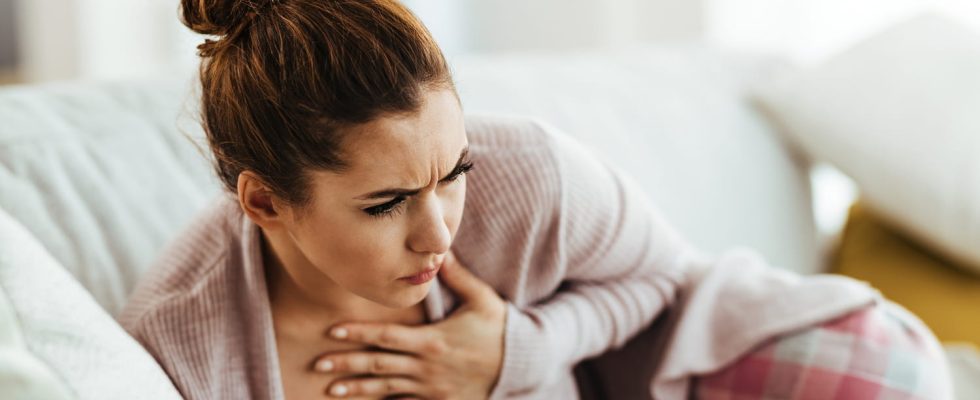Strange cases of pneumonia suspected of being linked to the bacteria Mycoplasma pneumoniae are observed in China and France in children and young adults. This illness initially resembles a cold but can progress to serious pneumonia.
China and now France are currently facing an increase in respiratory illnesses of mysterious originincluding pneumonia suspected of being linked to the bacteria Mycoplasma pneumoniae which mainly affects children and adolescents. The Directorate General of Health reported “an unusual increase” in cases in an urgent notice dated November 29. “It’s rarely a very nasty germso we are absolutely not not in the same situation as during Covid. But we still have to monitor and see how things evolve.” confirmed Dr Andreas Werner, pediatric allergist in Villeneuve-lès-Avignon (Gard) and president of the French Association of Ambulatory Pediatrics to our colleagues at La Croix. Typically, Mycoplasma pneumoniae outbreaks occur in populated environments like the schools, university residences, long-term care facilities and hospitals, mainly in the fall, with a peak at the start of winter and end in spring. Infections linked to Mycoplasma pneumoniae affected France in 2010 and 2011.
What is the Mycoplasma pneumoniae bacteria?
Discovered in 1944, Mycoplasma pneumoniae is a bacterium capable of leading to infections of the lower respiratory tract – trachea, bronchi and lungs – in humans but particularly in adolescent children and young adults. These infections are usually benign but can be more serious in some people (with a weakened immune system or history of breathing illness) requiring hospital care. “Compared to other pathogens, Mycoplasma pneumoniae is atypical. (…) It grows slowly, requires close contact for transmission, and has a distinct disease presentation (atypical pneumonia).” explain researchers in a Lancet article published on November 23, 2023,
What are the symptoms in adults?
The most common type of infection is tracheobronchitis (nicknamed “chest cold”), whose typical symptoms are:
- A sore throat
- Tiredness
- Moderate to high fever
- A cough that gets worse slowly (may be purulent) and may last for several weeks
- Headaches
- Muscle pain
What are the symptoms in children?
THE children under 5 years old infected with Mycoplasma pneumoniae may present different symptoms those of older children and adults:
- Sneezing
- A blocked or runny nose
- Sore throat
- Tears
- A wheezing
- Of the digestive symptoms such as feeling sick, vomiting and diarrhea
People can have the bacteria in their nose or throat at one time or another without being sick: they are said to be healthy carriers. When an infected person coughs or sneezes, they secrete small droplets containing the bacteria, which can thus infect other people breathing these droplets. Of the serological tests or PCR (laboratory) are used to diagnose Mycoplasma pneumoniae infections. Immunoenzymatic techniques can reveal the presence of antibodies IgM and IgG and contribute to early diagnosis infections Mycoplasma.
Pneumonia, main complication
The main complication of Mycoplasma pneumoniae infection is pneumonia the typical symptoms of which can appear after 1 to 4 weeks: high fever, chills, severe fatigue, shortness of breath and breathing difficulties. Other complications, rarercan occur: encephalitis (swelling of the brain), hemolytic anemia (not enough red blood cells), kidney dysfunction, skin disorders such as Stevens-Johnson syndrome, erythema multiforme, toxic epidermal necrolysis, etc.
What treatment? An antibiotic ?
The majority of patients recover without treatment, with time and rest, sometimes over-the-counter medications to relieve symptoms. Disease heals in 2 to 4 weeks. However, when treatment is necessary, it is a matter ofantibiotics (azithromycin, doxycycline or, sometimes, levofloxacin or moxifloxacin) prescribed by a doctor. There is no vaccine to prevent Mycoplasma pneumoniae infections.
4 good actions to protect yourself
► Cover your mouth and nose with a tissue when you cough or sneeze.
► Put your used tissues in a trash can.
► Wash your hands often with soap and water for at least 20-30 seconds.
► If soap and water are not available, use an alcohol-based hand sanitizer.
- Mycoplasma pneumoniae Infections – Centers for Disease Control and Prevention (CDC)
- Epidemiology of Mycoplasma pneumoniae infections – Public Health France
